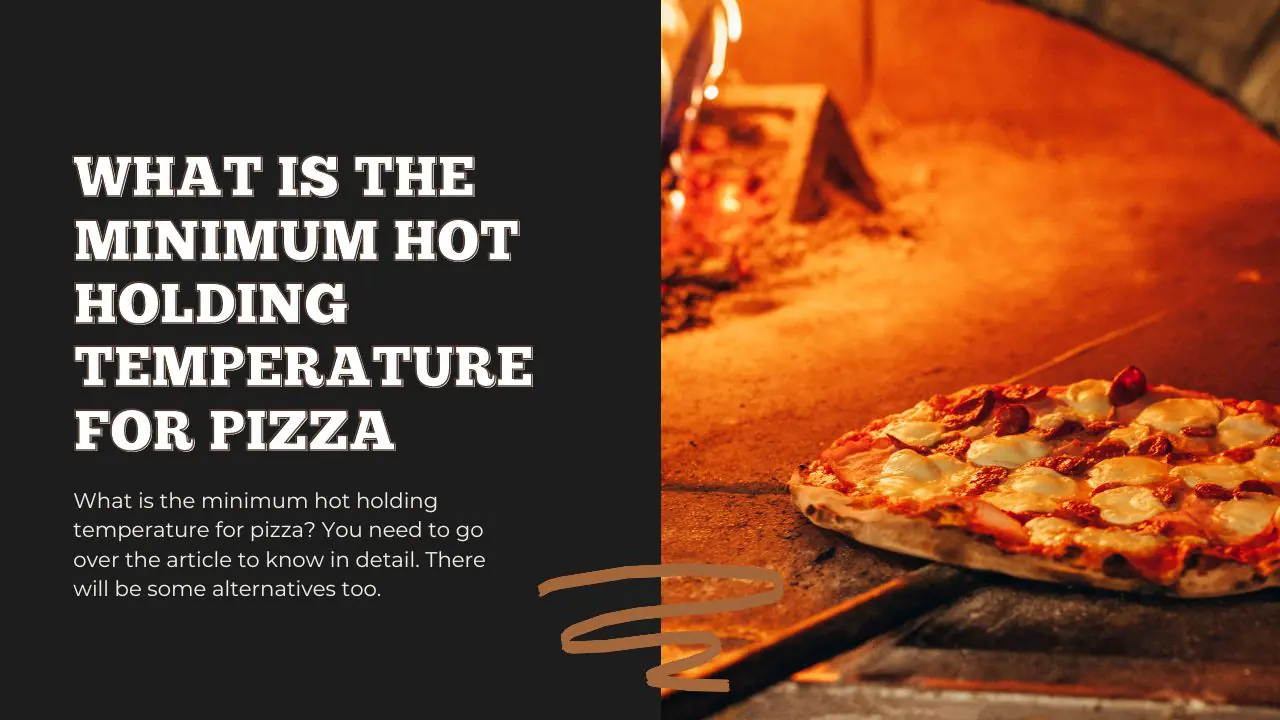The minimum hot holding temperature for pizza is 135°F (57°C). Proper hot holding is essential for ensuring food safety and preventing the growth of bacteria.
Pizza is a popular dish enjoyed by people of all ages and backgrounds. Whether it’s a classic pepperoni or a gourmet Neapolitan, pizza is a versatile and favorite food choice for many. However, keeping pizza at the right temperature is crucial to maintain its quality and prevent foodborne illnesses.
Health regulations require that hot foods like pizza should be held at a minimum temperature of 135°F to ensure that harmful bacteria do not multiply. We’ll explore the importance of proper hot holding for pizza and provide tips for maintaining the ideal temperature to keep your pizzas safe and delicious.
Ensuring Pizza Safety Standards
Pizza is a beloved food worldwide, but it’s important to prioritize safety when it comes to serving this delicious dish. Maintaining the proper temperature when holding pizza is crucial to preventing foodborne illnesses and upholding food safety standards. Let’s explore the essential guidelines, importance, and regulatory compliance related to hot holding temperature for pizza to ensure safe consumption.
Food Safety Guidelines For Pizza
When it comes to hot-holding pizza, the food safety guidelines specify that it should be maintained at a minimum temperature of 135°F (57°C) to hinder the growth of harmful bacteria. Ensuring that pizza is kept at this designated temperature helps in preserving its quality and safety for consumption. It’s essential to follow these guidelines to protect the health of customers and maintain high-quality standards.
Importance Of Maintaining Proper Temperature
Maintaining the proper hot holding temperature for pizza is vital as it prevents the growth of bacteria such as Salmonella, E. coli, and Listeria, which can cause foodborne illnesses when ingested. Additionally, serving pizza at the correct temperature ensures that customers receive a safe and enjoyable dining experience, supporting the reputation and trust of the pizzeria.
Regulatory Bodies And Standards Compliance
In the culinary industry, compliance with regulations and standards is non-negotiable. Several regulatory bodies, such as the Food and Drug Administration (FDA) and the Centers for Disease Control and Prevention (CDC), have established specific guidelines for hot holding temperatures to guarantee food safety. Adhering to these regulations not only protects consumers but also safeguards the reputation and legal status of the pizzeria.

Credit: www.pizzabien.com
The Science Behind Hot Holding
Hot holding is a critical practice in the food industry to prevent the growth of harmful bacteria in prepared foods. It involves maintaining a specific minimum temperature to ensure the safety and quality of the food, particularly in the case of popular items like pizza. Understanding the science behind hot holding can shed light on the role of temperature in bacteria growth, the importance of heat retention in preventing contamination, and the key principles in hot holding methodologies.
Role Of Temperature In Bacteria Growth
Bacteria require specific temperature conditions for growth. When it comes to hot-holding pizza, it’s essential to understand that bacteria thrive at temperatures between 40°F and 140°F. This temperature range is known as the danger zone, where bacteria can multiply rapidly, leading to foodborne illnesses if the food is not held at safe temperatures. Therefore, maintaining a minimum hot holding temperature for pizza is crucial to inhibit the growth of harmful pathogens.
How Heat Retention Prevents Contamination
Heat retention is a key factor in preventing contamination during hot holding. By ensuring that the pizza is held at a minimum temperature, such as 135°F or higher, heat effectively inhibits the growth of bacteria. This prevents contamination and helps maintain the quality and safety of the pizza for consumption. Proper insulation and heat sources are essential for maintaining the required temperature consistently, minimizing the risk of microbial contamination.
Key Principles In Hot Holding Methodologies
Effective hot-holding methodologies involve several key principles to ensure food safety. These include regular temperature monitoring, using insulated containers or heating equipment, and establishing clear standard operating procedures for hot holding practices. By adhering to these principles, food establishments can minimize the risk of bacterial growth and maintain the integrity of the pizza, keeping it safe for consumption.
Hot Holding Temperature For Pizza
When it comes to serving delicious and safe pizza, maintaining the proper hot holding temperature is crucial. Let’s dig into the current industry standards for pizza, explore the temperature thresholds, and understand how different pizza components can affect these holding temperatures.
Current Industry Standards For Pizza
The food industry adheres to strict regulations when it comes to hot holding temperatures for perishable items like pizza. According to the Food and Drug Administration (FDA), the minimum hot holding temperature for pizza should be 135°F (57°C). This is in line with food safety guidelines to prevent bacterial growth and ensure that the pizza remains safe for consumption.
Temperature Thresholds Explained
Understanding the temperature thresholds is essential to guarantee the safety and quality of hot-held pizzas. 135°F (57°C) serves as the threshold temperature as it effectively kills harmful pathogens and bacteria, safeguarding the pizza from potential contaminants. Maintaining this temperature helps preserve the taste and texture of the pizza while upholding food safety standards.
How Pizza Components Affect Holding Temperatures
Various components of a pizza can impact its hot holding temperature. From the moisture content of toppings to the thickness of the dough, each element plays a role in influencing the overall heat retention. For instance, pizzas with high-moisture ingredients may require slightly higher holding temperatures to prevent sogginess and microbial growth.
Monitoring And Controlling Heat
Monitoring and controlling heat is crucial in any food establishment, especially when it comes to maintaining the minimum hot holding temperature for pizza. Consistency is key to ensuring the quality and safety of the product. In this section, we will explore the tools and strategies essential for maintaining and monitoring the heat, as well as the importance of training staff in temperature management.
Tools And Equipment For Temperature Maintenance
When it comes to maintaining the minimum hot holding temperature for pizza, having the appropriate tools and equipment is essential. The following table outlines some of the essential tools and equipment:
| Tool/Equipment | Description |
| Food thermometer | Used to accurately measure the internal temperature of the pizza to ensure it meets the minimum hot holding requirement. |
| Oven with thermostat | An oven with an accurate thermostat is vital for maintaining consistent heat levels during hot holding. |
Strategies For Consistent Heat Management
Consistency in heat management is essential for ensuring that the pizza is held at the minimum hot holding temperature. Here are some effective strategies:
- Regular temperature checks: Implement a schedule for regular temperature checks to ensure that the hot holding temperature is consistently maintained.
- Calibration of equipment: Regularly calibrate thermometers and ovens to ensure accuracy in temperature readings.
- Proper insulation: Ensure that the hot holding equipment is properly insulated to minimize heat loss.
Training Staff In Maintaining Temperatures
It is essential to train the staff responsible for hot holding in temperature maintenance techniques. Please provide them with hands-on training and guidelines on how to monitor and adjust temperatures to ensure the pizza is consistently held at the minimum hot holding temperature, thus maintaining its quality and safety.
Implementing Food Safety Practices
Implementing food safety practices is crucial for any food establishment, especially when it comes to maintaining the proper hot holding temperature for pizza. This not only ensures the quality and taste of the pizza but also the safety of your customers. Undercooked or improperly stored pizza can lead to foodborne illnesses, which can tarnish the reputation of your business. Here, we will discuss the steps to meet the minimum hot holding requirements, case studies of effective food safety enforcement, and common challenges in maintaining proper temperature.
Steps To Meet The Minimum Hot Holding Requirements
In order to meet the minimum hot holding requirements for pizza, it is essential to follow these steps:
- Invest in quality heating equipment: Ensure that your food holding equipment is capable of maintaining the minimum hot holding temperature for pizza, usually set at 135°F or 57°C.
- Regular temperature checks: Implement a routine schedule for checking the hot holding temperature of your pizza to ensure it stays within the safe range.
- Proper storage: Store the pizza in dedicated hot holding cabinets or warming trays to maintain its temperature until serving.
- Employee training: Educate your staff on the importance of maintaining hot holding temperatures and provide them with the necessary tools and resources to monitor and regulate the temperature.
Case Studies Of Effective Food Safety Enforcement
Let’s take a look at some real-life examples of effective food safety enforcement:
| Case Study | Details |
| Pizzeria X | Implemented a strict monitoring system for hot holding temperatures, resulting in zero cases of foodborne illnesses over the past 5 years. |
| Chain Restaurant Y | Invested in state-of-the-art hot holding equipment and provided comprehensive training to their staff, leading to an increase in customer satisfaction and positive reviews. |
Common Challenges In Maintaining Proper Temperature
Despite efforts to maintain the minimum hot holding temperature for pizza, food establishments often face the following challenges:
- Inadequate equipment: Outdated or malfunctioning hot holding equipment can make it challenging to maintain the required temperature consistently.
- Human error: Staff oversight or negligence in monitoring the hot holding temperature can lead to deviations from the safe range.
- Rush periods: During peak hours, it can be difficult to manage hot holding temperatures due to the high volume of pizza orders.
Frequently Asked Questions For What Is The Minimum Hot Holding Temperature For Pizza
What Is The Minimum Hot Holding Temperature For Pizza?
To ensure food safety, the minimum hot holding temperature for pizza is 135°F or 57°C.
Why Is It Important To Maintain The Hot Holding Temperature For Pizza?
Maintaining the hot holding temperature prevents bacterial growth and ensures the pizza remains safe for consumption.
How Can I Check The Hot Holding Temperature For Pizza At Home?
Use a food thermometer to accurately measure the temperature of the pizza, ensuring it stays above 135°F or 57°C.
Conclusion
Maintaining the minimum hot holding temperature for pizza is crucial for food safety. By following the proper temperature standards, you can ensure that your pizza remains safe and enjoyable for your customers. Remember, complying with these regulations not only keeps your customers happy but also protects your business from potential liabilities.
Always prioritize food safety in your operations.

As the author of the “Ultimate Pizza Guide: Recipes, Tips & Secrets Revealed,” I’m dedicated to sharing my love for pizza and empowering others to create delicious homemade pizzas with ease. Join me on a journey to uncover the secrets to perfecting your pizza game!



